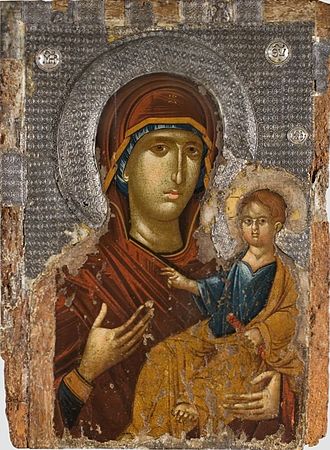- Home
- About us
- Students
- Courses
- Research
- Library
- News & Events
- Gallery
- Contact
- Our Blog
Latest News

The Akathist Hymn

by Dr Andrew Mellas (Senior Lecturer in Church History and Liturgical Studies)
The Akathist Hymn, which is a masterpiece of Byzantine hymnography dedicated to the Mother of God, is a song close to the hearts of the Orthodox faithful. It is called ‘Akathist’ (which means ‘not sitting’) because during a vigil held in thanksgiving to the Virgin Mary, who delivered Constantinople from invasion in the seventh century, the Byzantines chanted the Akathist Hymn and everyone remained standing during this vigil. According to the sources, during the Avar siege of Constantinople in 626 AD, the King of the Avars looked up at the walls of the city while his fleet was being destroyed and saw a woman in shining garments with a face full of light. And, of course, that woman was the Theotokos.
It was also during this historical event in the seventh century that the famous prelude to the Akathist Hymn was composed:
O Theotokos, to you, my champion commander, I your city, redeemed from disasters, dedicate hymns of victory and thanksgiving; and as you have unassailable might, set me free from every kind of danger, that I may cry to you: “Rejoice, unwedded bride!”.
It is only in this prelude added to the Akathist Hymn that one finds an allusion to the Theotokos saving Constantinople from invaders. The 24 stanzas of the Akathist Hymn do not portray the Virgin Mary as the protectress of Constantinople. In fact, the hymn explores the Virgin’s role in the story of salvation, focusing on the Annunciation, the Nativity of Christ and other biblical events.
Indeed, the Akathist Hymn was sung in Byzantium well before the seventh century. It was originally sung during the celebration of the Annunciation of the Theotokos. In the early church, before the sixth century, the Annunciation was connected with the feast of Christmas and the Akathist Hymn was probably sung during 26 December, which was the Synaxis of the Theotokos. Over time, the feast of the Annunciation moved to 25 March, probably during the reign of Emperor Justinian in the sixth century. And during this period, the Akathist Hymn followed the shift of the celebration of the Annunciation. However, there was a problem with celebrating the Annunciation during Lent if it fell on a weekday. In the spirit of Canon 51 of the Council of Laodicea, such Lenten celebrations had to move to the following Saturday or Sunday. So, there appears to be a shift of the feast of the Annunciation to a Saturday during Great Lent, at which point, the Akathist Hymn followed the celebration of the Annunciation to the fifth Saturday of Lent. But in 692 AD, the Council in Trullo decreed that the Annunciation must be celebrated on 25 March, even if it falls on a weekday of Lent. Soon thereafter, the Saturday of the Akathist Hymn in the fifth week of Great Lent became a celebration of the deliverance of Constantinople from invaders.
While this history might be interesting, to understand the significance of the Akathist hymn, we need to be familiar with typology, which is the study of prefiguration and how an object or event in the Old Testament typified or foreshadowed a greater event in the New Testament. For example, the Burning Bush that Moses encountered was a prefiguration of the Virgin Mary. Just as the Burning Bush was not consumed by the flame, so the Virgin Mary held in her womb the fire of God himself, and remained a virgin even during the act of giving birth. That is why it is no coincidence that the portrayal of the Virgin as this miraculous burning bush emerges in the hymnody of the Akathist.
Another example is Jacob’s ladder which, according to the book of Genesis, was set up on the earth, with its top reaching to heaven; and the angels of God were ascending and descending on it. Jacob’s ladder represents the function of the Virgin Mary as a bridge between the divine and created worlds. And we encounter this typology in the Akathist Hymn when we sing: “Rejoice heavenly ladder, by which God descended, rejoice bridge leading those on earth to Heaven.”
There is also in the hymn the image of the ark of the covenant, which contained the ten commandments, the manna from heaven and the priestly rod of Aaron. In a similar fashion, the Theotokos contained in her womb Christ who is the fulfilment of these three things: the fulfilment of the law, the true bread of life, and the eternal High Priest.
In conclusion, the Akathist Hymn is a poetic, musical and theological celebration of the Mother of God, which invites us to experience the story of salvation. Even though this story is a familiar one—we know how it begins, we know its twists and turns, and we know how it ends—in experiencing the songs that tell us this story, we do not just listen. We enter this sacred narrative, and we become protagonists in the story that unfolds. We are invited to embark on a liturgical journey to Pascha. We begin by standing beside Adam and Eve in Paradise, and we cry with them as we are exiled from the Garden of Eden. We travel to faraway lands and feel nostalgia as we weep for our homeland. We feel the hope of the Annunciation and the love of God who became human. We suffer with Christ as he willingly embraces his passion. We are crucified with him. We descend into Hades with him. And we arise with him on the day of the Resurrection—a day which has no evening. Therefore, the Akathist Hymn is a source of hope during Great Lent—and we never hope alone. The Mother of God is always close to us, and she stands only a single thought away. Indeed, in the liturgy, we never sing alone. During the Akathist Hymn, we sing together: “Rejoice, unwedded bride!”



.png)